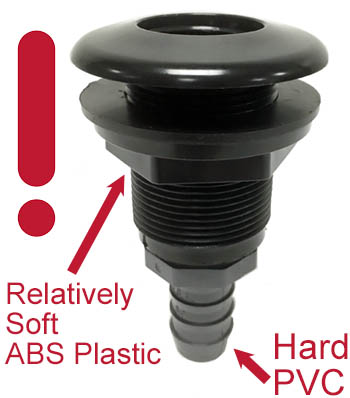
Many plumbing fittings look the same but are made of different materials. What are the differences between the materials, and which ones should you purchase? Here is a brief introduction to the different types of plumbing materials you will find.
PVC
PVC stands for PolyVinyl Chloride. PVC is a durable plastic used in many aquarium applications. PVC is harder than any of the other materials on this list and it can be glued easily with PVC cement you can find at any hardware store. PVC comes in multiple thicknesses, Schedule 40 being standard and Schedule 80 being extra thick.
PVC is good when you are gluing connections together, where there is high water pressure, and when you are using a UV sterilizer. Many of the other plastics listed degrade under UV light if you connect a UV sterilizer with them. Eventually the plastic will be eaten away by the light and cause a leak.
ABS
ABS stands for Acrylonitrile Butadiene and Styrene. ABS plastic is most commonly used in the black bulkhead fittings and intake strainers. ABS is softer than PVC but more durable than many other plastics.
One thing to keep in mind when using ABS fittings is that
you should never screw a harder material into a softer material (or a softer material into a harder material). Because of this, we do not recommend screwing PVC fittings into ABS bulkheads. It is better to use a nylon insert or a bulkhead with a slip connection where the joint can be glued with PVC cement. If you must have all PVC parts the gray Schedule 80 bulkheads are made of PVC and are perfectly fine to screw PVC fittings into.
Nylon
Nylon is a soft material commonly used for threaded insert adapters. Because nylon is soft, there is less risk of cracking fittings when you screw a nylon fitting into another fitting.
You may not realize it, but MPT fittings are tapered and arenít designed to go in all the way. The more you screw in the fitting the more pressure you put on the FPT fitting you are screwing into. If you over tighten the fitting, one of the two fittings will give. If the FPT fitting is softer than the MPT fitting, the FPT fitting will crack and lead to horrible leaks. Worse yet, the stress from over tightening a fitting can cause a crack over time once the aquarium is filled with water, fish and coral.
To avoid these problems we suggest using the nylon insert fittings so that if you over-insert the fitting, the nylon will bend rather than stress the FPT fitting and cause leaks.
Polypropylene
Polypropylene is a plastic that behaves in a similar manner to nylon. Often nylon and polypropylene fittings can be used interchangeably. Polypropylene is slightly softer and cheaper than nylon and is usually black rather than white.
Kynar
Kynar is a specialized material specifically designed for ozone resistance for aquariums with ozone generators. Now that ozone usage has become less popular, there is rarely a need for most aquarists to purchase expensive kynar fittings.
Generic Plastic
Some plumbing fittings, such as the ones from Two Little Fishies, do not specify what kind of plastic they use. Most of these fittings behave like ABS plastic. They are not as soft as nylon or polypropylene but also not as hard as PVC. These fittings are perfectly suitable for use but should not be glued using PVC cement.




























 Many plumbing fittings look the same but are made of different materials. What are the differences between the materials, and which ones should you purchase? Here is a brief introduction to the different types of plumbing materials you will find.
Many plumbing fittings look the same but are made of different materials. What are the differences between the materials, and which ones should you purchase? Here is a brief introduction to the different types of plumbing materials you will find.